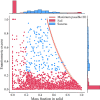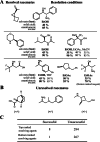Predictive design of crystallographic chiral separation
- PMID: 40858574
- PMCID: PMC12381160
- DOI: 10.1038/s41467-025-62825-4
Predictive design of crystallographic chiral separation
Abstract
The efficient separation of chiral molecules is a fundamental challenge in the manufacture of pharmaceuticals and light-polarising materials. We developed an approach that combines machine learning with a physics-based representation to predict resolving agents for chiral molecules, using a transformer-based neural network. In retrospective tests, our approach reaches a four to six-fold improvement over the historical - trial and error based - hit rate. We further validate the model in a prospective experiment, where we use the model to design a resolution screen for six unseen racemates. We successfully resolved three of the six mixtures in a single round of experiments and obtained an overall 8-to-1 true positive to false negative ratio. Together with this study, we release a previously proprietary dataset of over 6000 resolution experiments, the largest diastereomeric salt crystallisation dataset to date. More broadly, our approach and open crystallisation data lay the foundation for accelerating and reducing the costs of chiral resolutions.
© 2025. The Author(s).
Conflict of interest statement
Competing interests: A.A.L. is a co-founder and owns equity in PostEra Inc. and Byterat Ltd. L.B., S.B., X.H., J.L.K.M., J.M., N.W.S., Q.Y., and R.M.H. are employed by Pfizer Inc. WPF is employed by Virscidian Inc. and formerly at Pfizer. F.A.F. is employed by AstraZeneca at the time of publication; however, none of the work presented in this manuscript was conducted at or influenced by this affiliation. The remaining authors declare no competing interests.
Figures






References
-
- Yang, Y., da Costa, R. C., Fuchter, M. J. & Campbell, A. J. Circularly polarized light detection by a chiral organic semiconductor transistor. Nat. Photon.7, 634–638 (2013).
-
- Schulz, M. et al. Chiral excitonic organic photodiodes for direct detection of circular polarized light. Adv. Funct. Mater.29, 1900684 (2019).
-
- Wu, Z.-G. et al. Chiral octahydro-binaphthol compound-based thermally activated delayed fluorescence materials for circularly polarized electroluminescence with superior EQE of 32.6% and extremely low efficiency roll-off. Adv. Mater.31, 1900524 (2019). - PubMed
LinkOut - more resources
Full Text Sources
Other Literature Sources

